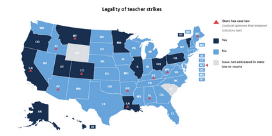State policies, even in the form of guidance, often shape how local authorities define their own policies. We saw it earlier this year when we analyzed how states’ recommended admission policies for getting into a teacher preparation program, while non-binding, still influence the admissions standards set by programs.
But what about state policies regarding collective bargaining? Collective bargaining for teachers is required in 34 states,1 permissible in 10 other states, and explicitly prohibited in seven states. Research also finds that state rules about collective bargaining have an impact on the substance and outcomes, not just the process, of local collective bargaining agreements between teachers and districts.
In this District Trendline we cross-examine the state rules on collective bargaining and the content of districts’ policies. We look at three areas—teacher evaluation, layoffs, and wages—across the 148 school districts in NCTQ’s sample.2 The analysis reveals interesting trends between districts’ policies, depending on whether their state mandates, permits, or prohibits the negotiation of those three areas between districts and teachers unions.
Teacher evaluation
Of the 44 states that engage in collective bargaining, four (California, Massachusetts, New York, and Ohio) mandate that districts must negotiate with their teachers union on teacher evaluation. Seven states prohibit their districts from negotiating evaluation policy with their teachers union, and the remaining states permit it, either explicitly or tacitly.
We explore if there are clear differences in what those policies look like among these three categories of states. First we look at how much student achievement measures factor into districts’ teacher evaluations. For the purposes of this exercise, we use the guidance from the MET Project to establish a threshold for student achievement of 30% of the teacher’s score.
It turns out that the large districts in our sample that are required to negotiate evaluation policies with their union end up giving less weight to student achievement than the districts that opt to negotiate with their union. Only 17% of the districts with mandatory bargaining agreed to a weight of 30% or more for student achievement, compared to 46% of the districts that chose to negotiate the evaluation policy.
| Of the districts in our sample that require negotiation with their union, Cincinnati Public Schools (OH) is an outlier, requiring that objective measures of student achievement make up 40-50% of the overall teacher score, unlike other districts in Ohio where student achievement is not a component of the teacher evaluation score. |
There are, of course, other factors to settle about teacher evaluation, such as how often a teacher must be observed. For the purposes of this analysis, we chose a threshold of three observations per evaluation cycle, which research suggests is the minimum number of observations needed to generate a reliable score.
The differences in this area of evaluation are less notable. While only 17% of the districts where negotiation is mandatory meet the three observations threshold for their tenured teachers (which, given the consistency with the student achievement policies, raises interesting questions), only 25% of the districts where bargaining is prohibited, and 27% of the districts that may choose to negotiate meet that same threshold. Other factors beyond district autonomy appear to be at play. Furthermore, there was virtually no difference between districts in all categories of states on the number of observations concerning non-tenured teachers; about half of all districts, regardless of whether they negotiate evaluation policy, require that non-tenured teachers be observed at least three times.
Still, in those states that leave it up to their districts to decide if they want to negotiate evaluation, districts in our sample are more likely to provide their teachers with more observations throughout the year than districts in the states where they must negotiate.
| Aurora Public Schools, located in a state that leaves it up to districts to decide if they want to negotiate evaluation policy, requires five observations for teachers regardless of tenure status, while most other districts in Colorado require only one or two. |
Layoffs
Next we turn our attention to district policies on teacher layoffs. In analyzing the predominant criteria used by districts when teachers must be laid off, we find clear differences in policies depending on whether the large districts in our sample are mandated, permitted, or prohibited to negotiate layoffs with their teachers union.
In the districts that are required to negotiate layoff policies, nearly 80% look to teacher seniority as either the preponderant or sole criterion used. However, that percentage shrinks to 34% in the districts that choose to bargain, and to 13% in the districts that are not permitted to bargain layoff policies.
While there are only ten states that mandate that their districts negotiate layoffs, 94% of the districts where negotiating layoffs is neither mandated nor prohibited still opt to negotiate. These “opt-in” districts make for interesting study: in spite of the fact that they negotiate with the unions and unions tend to be strongly supportive of seniority as the primary criterion, these districts often achieve other results.
| Toledo Public Schools (OH) is an example of such a district. The layoff policy in the district has changed in the last few years, from utilizing seniority as the sole criterion for layoffs to having performance as the preponderant criterion. |
Compensation
Finally, we examine how state rules of collective bargaining affect district teacher compensation policies in the large districts we studied. The analysis did not find significant differences between average wages depending on whether districts were mandated, permitted, or prohibited to negotiate wages. The larger differences were found in differentiated pay policies; in particular, differences in pay for teachers in high-need subjects or schools and extra pay for advanced degrees.
When it comes to differentiated pay for teachers in high-needs schools or subjects, about 60% of all districts in our sample offer premiums for teachers in high-needs schools or subjects, regardless of whether negotiating salary is mandated, permitted, or prohibited by state collective bargaining rules.
However, according to our sample, in the districts that offer this type of differentiated pay, the average premium is 60% larger in districts where negotiating salaries is prohibited than in districts that are mandated to do so. Perhaps even more astounding is that districts that choose to negotiate salaries offer premiums for teachers in high-needs schools or subjects that almost triple those in districts where salary negotiation is mandated.
| While this type of differentiated pay trends higher in districts where collective bargaining does not exist, Albuquerque Public Schools (NM) and Clark County School District (NV) buck the trend by providing large bonuses near $10,000 to teach in a high-needs school or subject, with wages being a mandated item to bargain, proving that collective bargaining is not an impediment to strategic pay. |
We also observe large differences in district compensation policies regarding premiums for advanced degrees. In the large districts where wages must be negotiated, premiums for master’s degrees can amount up to nearly $30,000, and on average are more than twice the corresponding premiums in the districts where collective bargaining of salaries is prohibited. Also, in the latter group, 20% of districts offer zero premium for master’s degrees, while in districts that must negotiate salaries only 5% of districts set their master’s premiums at zero.
Conclusion and recommendations
This analysis shows revealed preferences of school district authorities and teachers unions in large school districts on the topics of teacher evaluation, layoffs, and differentiated pay, made evident by where those policies tend to land—depending on whether those policy areas must, may, or cannot be negotiated. The clear contrast between the resulting policies in these three groups of large districts continues to cast light on the influence of state policies on the content of district policies.
Perhaps the biggest takeaway from this analysis for district and union leaders comes from where districts and unions choose to negotiate, yet align their policies with research that has demonstrated greater educational gains, such as the 45% of large districts that choose to bargain on layoffs and use performance as the preponderant criterion.
No less important is the lesson learned from the smaller percentage of large districts that are required to bargain, yet still find a way to produce evidence-based policies, such as those districts that must negotiate wages and still allocate resources for high-needs subjects or schools instead of master’s degrees.
This means that public education could potentially reap great rewards if both sides of the bargaining table learn from those districts already paving the way and relying on evidence-based policies. Districts and unions together can clearly achieve policies that benefit the greater educational outcomes, as opposed to mainly their constituency, and do not need to persist on the status quo.
More like this

How evaluation ratings impact teacher pay

Collective bargaining and teacher strikes
This month, the District Trendline highlights the role of collective bargaining in teacher strikes, takes a look at what teachers have won in recent strikes in Denver, Los Angeles, and Oakland, and makes a prediction of where teachers might strike next.
Endnotes
- Collective bargaining in these states is required where a majority of teachers vote for union representation.
- NCTQ’s Teacher Contract Database sample includes the nation’s largest 100 districts, the largest district in those states not otherwise represented, as well as the districts that are members of the Council of Great City Schools.

